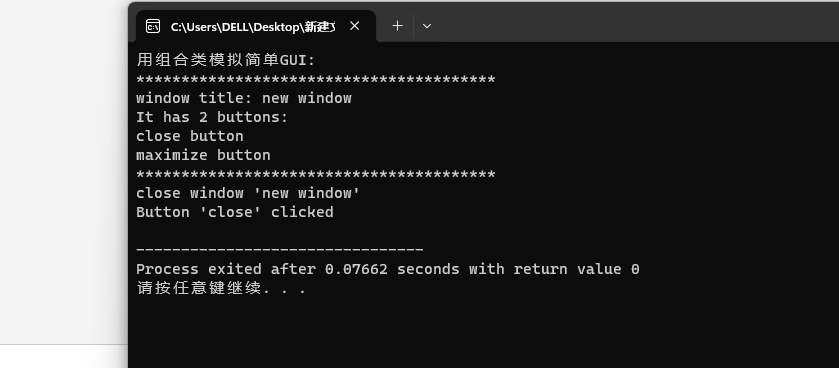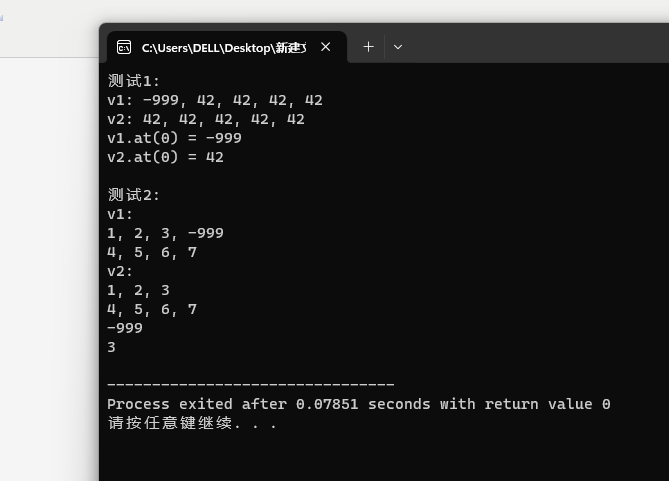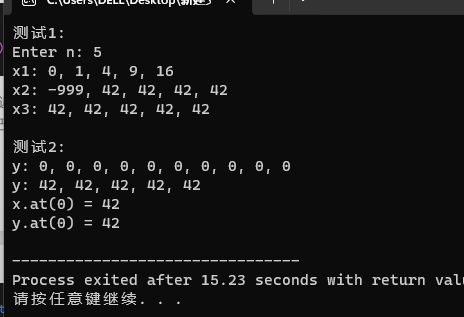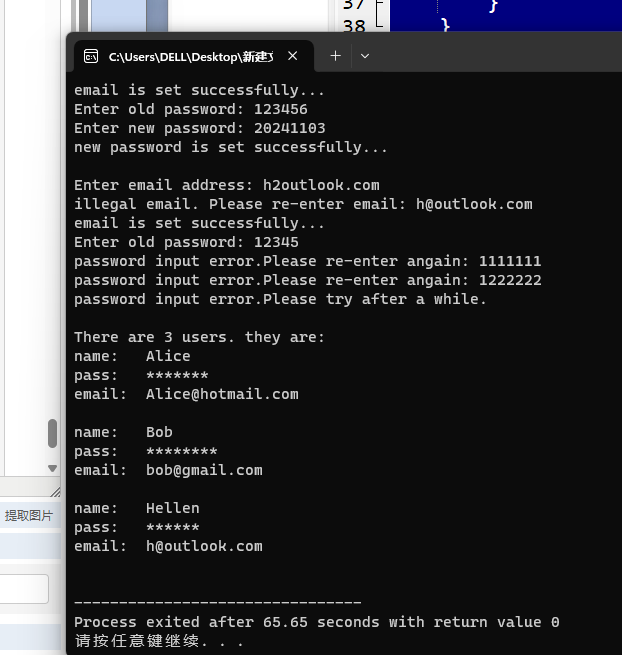实验3 类和对象 基础编程
实验一
task1.cpp
#include "window.hpp" #include <iostream> using std::cout; using std::cin; void test() { Window w1("new window"); w1.add_button("maximize"); w1.display(); w1.close(); } int main() { cout << "用组合类模拟简单GUI:\n"; test(); }
button.hpp
#pragma once #include <iostream> #include <string> using std::string; using std::cout; // 按钮类 class Button { public: Button(const string &text); string get_label() const; void click(); private: string label; }; Button::Button(const string &text): label{text} { } inline string Button::get_label() const { return label; } void Button::click() { cout << "Button '" << label << "' clicked\n"; }
window.hpp
#pragma once #include "button.hpp" #include <vector> #include <iostream> using std::vector; using std::cout; using std::endl; // 窗口类 class Window{ public: Window(const string &win_title); void display() const; void close(); void add_button(const string &label); private: string title; vector<Button> buttons; }; Window::Window(const string &win_title): title{win_title} { buttons.push_back(Button("close")); } inline void Window::display() const { string s(40, '*'); cout << s << endl; cout << "window title: " << title << endl; cout << "It has " << buttons.size() << " buttons: " << endl; for(const auto &i: buttons) cout << i.get_label() << " button" << endl; cout << s << endl; } void Window::close() { cout << "close window '" << title << "'" << endl; buttons.at(0).click(); } void Window::add_button(const string &label) { buttons.push_back(Button(label)); }
实验结果

问题一:自定义了一个窗口类和一个按钮类,运用了标准库的输入输出类,容器类,string类;容器类和输入输出类在自定义类有组合关系。
问题二:const 是只能调用而不能修改,inline是内联函数,可以对一些简单函数多次重复调用时使用。所以对于尚未设置的函数,观察是否值得保护还是会多次重复调用而来决定选择哪个
问题三:这行代码,可以输出一行40个*作为分割线
实验二
#include <iostream> #include <vector> using namespace std; void output1(const vector<int> &v) { for(auto &i: v) cout << i << ", "; cout << "\b\b \n"; } void output2(const vector<vector<int>> v) { for(auto &i: v) { for(auto &j: i) cout << j << ", "; cout << "\b\b \n"; } } void test1() { vector<int> v1(5, 42); const vector<int> v2(v1); v1.at(0) = -999; cout << "v1: "; output1(v1); cout << "v2: "; output1(v2); cout << "v1.at(0) = " << v1.at(0) << endl; cout << "v2.at(0) = " << v2.at(0) << endl; } void test2() { vector<vector<int>> v1{{1, 2, 3}, {4, 5, 6, 7}}; const vector<vector<int>> v2(v1); v1.at(0).push_back(-999); cout << "v1: \n"; output2(v1); cout << "v2: \n"; output2(v2); vector<int> t1 = v1.at(0); cout << t1.at(t1.size()-1) << endl; const vector<int> t2 = v2.at(0); cout << t2.at(t2.size()-1) << endl; } int main() { cout << "测试1:\n"; test1(); cout << "\n测试2:\n"; test2(); }
结果

问题一:第21行代码是输出5个42,第22行是为了为了后续输出v2和v1一致,第23行是为了改变v1中第一个为-999
问题二:第32行代码是输出v1为二维数组,第33行是为了后续v2和v1输出一致,第34行是为了加第一行最后一个为-999
问题三:39行是复制输出v1到t1上的,40行是输出t1上的东西,42行是将constv2赋值到t2,43行是输出t2
问题四:是深复制,不需要
实验三
task3.cpp
#include "vectorInt.hpp" #include <iostream> using std::cin; using std::cout; void output(const vectorInt &vi) { for(auto i = 0; i < vi.get_size(); ++i) cout << vi.at(i) << ", "; cout << "\b\b \n"; } void test1() { int n; cout << "Enter n: "; cin >> n; vectorInt x1(n); for(auto i = 0; i < n; ++i) x1.at(i) = i*i; cout << "x1: "; output(x1); vectorInt x2(n, 42); vectorInt x3(x2); x2.at(0) = -999; cout << "x2: "; output(x2); cout << "x3: "; output(x3); } void test2() { const vectorInt x(5, 42); vectorInt y(10, 0); cout << "y: "; output(y); y.assign(x); cout << "y: "; output(y); cout << "x.at(0) = " << x.at(0) << endl; cout << "y.at(0) = " << y.at(0) << endl; } int main() { cout << "测试1: \n"; test1(); cout << "\n测试2: \n"; test2(); }
vectorInt.hpp
#pragma once #include <iostream> #include <cassert> using std::cout; using std::endl; // 动态int数组对象类 class vectorInt{ public: vectorInt(int n); vectorInt(int n, int value); vectorInt(const vectorInt &vi); ~vectorInt(); int& at(int index); const int& at(int index) const; vectorInt& assign(const vectorInt &v); int get_size() const; private: int size; int *ptr; // ptr指向包含size个int的数组 }; vectorInt::vectorInt(int n): size{n}, ptr{new int[size]} { } vectorInt::vectorInt(int n, int value): size{n}, ptr{new int[size]} { for(auto i = 0; i < size; ++i) ptr[i] = value; } vectorInt::vectorInt(const vectorInt &vi): size{vi.size}, ptr{new int[size]} { for(auto i = 0; i < size; ++i) ptr[i] = vi.ptr[i]; } vectorInt::~vectorInt() { delete [] ptr; } const int& vectorInt::at(int index) const { assert(index >= 0 && index < size); return ptr[index]; } int& vectorInt::at(int index) { assert(index >= 0 && index < size); return ptr[index]; } vectorInt& vectorInt::assign(const vectorInt &v) { delete[] ptr; // 释放对象中ptr原来指向的资源 size = v.size; ptr = new int[size]; for(int i = 0; i < size; ++i) ptr[i] = v.ptr[i]; return *this; } int vectorInt::get_size() const { return size; }
实验结果

问题一:是浅复制
问题二:能正常运行,可能有风险,对返回的对象进行修改
问题三:返回引用类型的话可以提高效率,并且避免歧义
实验四
tesk.cpp
#include "matrix.hpp" #include <iostream> #include <cassert> using std::cin; using std::cout; using std::endl; const int N = 1000; // 输出矩阵对象索引为index所在行的所有元素 void output(const Matrix &m, int index) { assert(index >= 0 && index < m.get_lines()); for(auto j = 0; j < m.get_cols(); ++j) cout << m.at(index, j) << ", "; cout << "\b\b \n"; } void test1() { double x[1000] = {1, 2, 3, 4, 5, 6, 7, 8, 9}; int n, m; cout << "Enter n and m: "; cin >> n >> m; Matrix m1(n, m); // 创建矩阵对象m1, 大小n×m m1.set(x); // 用一维数组x的值按行为矩阵m1赋值 Matrix m2(m, n); // 创建矩阵对象m1, 大小m×n m2.set(x); // 用一维数组x的值按行为矩阵m1赋值 Matrix m3(2); // 创建一个2×2矩阵对象 m3.set(x); // 用一维数组x的值按行为矩阵m4赋值 cout << "矩阵对象m1: \n"; m1.display(); cout << endl; cout << "矩阵对象m2: \n"; m2.display(); cout << endl; cout << "矩阵对象m3: \n"; m3.display(); cout << endl; } void test2() { Matrix m1(2, 3); m1.clear(); const Matrix m2(m1); m1.at(0, 0) = -999; cout << "m1.at(0, 0) = " << m1.at(0, 0) << endl; cout << "m2.at(0, 0) = " << m2.at(0, 0) << endl; cout << "矩阵对象m1第0行: "; output(m1, 0); cout << "矩阵对象m2第0行: "; output(m2, 0); } int main() { cout << "测试1: \n"; test1(); cout << "测试2: \n"; test2(); }
matrix.hpp
#pragma once #include <iostream> #include <cassert> using std::cout; using std::endl; // 类Matrix的声明 class Matrix { public: Matrix(int n, int m); // 构造函数,构造一个n*m的矩阵, 初始值为value Matrix(int n); // 构造函数,构造一个n*n的矩阵, 初始值为value Matrix(const Matrix &x); // 复制构造函数, 使用已有的矩阵X构造 ~Matrix(); void set(const double *pvalue); // 用pvalue指向的连续内存块数据按行为矩阵赋值 void clear(); // 把矩阵对象的值置0 const double& at(int i, int j) const; // 返回矩阵对象索引(i,j)的元素const引用 double& at(int i, int j); // 返回矩阵对象索引(i,j)的元素引用 int get_lines() const; // 返回矩阵对象行数 int get_cols() const; // 返回矩阵对象列数 void display() const; // 按行显示矩阵对象元素值 private: int lines; // 矩阵对象内元素行数 int cols; // 矩阵对象内元素列数 double *ptr; }; Matrix:: Matrix (int n, int m){ lines=n;cols=m;ptr= new double[n*m]; } Matrix:: Matrix(int n){ lines=cols=n; ptr= new double[n*n]; } Matrix::Matrix(const Matrix &x){ lines=x.lines; cols=x.cols; ptr=new double[x.lines,x.cols]; for(int i=0;i<lines*cols;i++){ *(ptr[i])=*(x.ptr[i]); } } void Matrix:: clear(){ *ptr=NULL; } Matrix::~Matrix(){ delete[] ptr; } void Matrix:: set(const double *pvalue){ for(int i=0;i<lines*cols;++i){ *(ptr+i)=*(ptr+i); } } const double& Matrix::at(int i, int j) const{ return *(ptr+i*cols+j); } double& Matrix::at(int i, int j){ return *(ptr+i*cols+j); } int Matrix:: get_lines() const{ return lines; } int Matrix:: get_cols()const{ return cols; } void Matrix:: display()const{ for(int i=0;i<lines;i++){ for(int j=0;j<cols;j++){ std::cout<<*(ptr+i*cols+j)<<","; } std::cout<<"endl"; } }
实验结果

实验五
test.cpp
#include "user.hpp" #include <iostream> #include <vector> #include <string> using std::cin; using std::cout; using std::endl; using std::vector; using std::string; void test() { vector<User> user_lst; User u1("Alice", "2024113", "Alice@hotmail.com"); user_lst.push_back(u1); cout << endl; User u2("Bob"); u2.set_email(); u2.change_password(); user_lst.push_back(u2); cout << endl; User u3("Hellen"); u3.set_email(); u3.change_password(); user_lst.push_back(u3); cout << endl; cout << "There are " << user_lst.size() << " users. they are: " << endl; for(auto &i: user_lst) { i.display(); cout << endl; } } int main() { test(); }
user.hpp
#pragma once #include <iostream> #include <cassert> #include<string> using std::cout; using std::endl; class User{ private: string name; string password; string email; public: User (string a){ name=a; password=123456; email=NULL; } User(string a,string b,string c){ name=a; password=b; email=c; } User::set_email(){ string a; std::cout<<"Enter email adress"; std::cout<<endl; std::cin>> a ; if(a.find('@')!=-1 ){ std::cout<<"email is set successfully..."; email=a; break; }else{ std::cout<<"illegal email.please re-enter email"; } } User::change_password(){ string b; std::cout<<"Enter old password"; std::cin>> b; if(b==password){ break; }else{ std::cout<<"password input error.Please re-enter again: "; std::cin>>b; }if(b==password){ break; }else{ std::cout<<"password input error.Please re-enter again:" ; std::cin>>b; }if(b!=password){ std::cout<<"password input error.Please try after a while"; } User::display(){ stirng c(password.size(),"*") std::cout<<"email: "<<email<<endl; std::cout<<"password: "<<c<<endl; std::cout<<"name: "<<name<<endl; } };
实验结果:

实验六
date.h
#ifndef __DATE_H__
#define __DATE_H__
class Date {
private:
int year;
int month;
int day;
int totalDays;
public:
Date(int year, int month, int day);
int getYear() const { return year; }
int getMonth() const { return month; }
int getDay() const { return day; }
int getMaxDay() const;
bool isLeapYear() const {
return year % 4 == 0 && year % 100 != 0 || year % 400 == 0;
}
void show() const;
int distance(const Date & date) const {
return totalDays - date.totalDays;
}
};
#endif
date.cpp
#include "date.h" #include <iostream> #include <cstdlib> using namespace std; namespace { const int DAYS_BEFORE_MONTH[] = { 0, 31, 59, 90, 120, 151, 181, 212, 243, 273, 304, 334, 365 }; } Date::Date(int year, int month, int day) : year(year), month(month), day(day) { if (day <= 0 || day > getMaxDay()) { cout << "Invalid date: "; show(); cout << endl; exit(1); } int years = year - 1; totalDays = years * 365 + years / 4 - years / 100 + years / 400 + DAYS_BEFORE_MONTH[month - 1] + day; if (isLeapYear() && month > 2) totalDays++; } int Date::getMaxDay() const { if (isLeapYear() && month == 2) return 29; else return DAYS_BEFORE_MONTH[month] - DAYS_BEFORE_MONTH[month - 1]; } void Date::show() const { cout << getYear() << "-" << getMonth() << "-" << getDay(); }
account.h
#ifndef __ACCOUNT_H__ #define __ACCOUNT_H__ #include "date.h" #include <string> class SavingsAccount { private: std::string id; double balance; double rate; Date lastDate; double accumulation; static double total; void record(const Date & date, double amount, const std::string & desc); void error(const std::string & msg) const; double accumulate(const Date & date) const { return accumulation + balance * date.distance(lastDate); } public: SavingsAccount(const Date & date, const std::string & id, double rate); const std::string & getId() const { return id; } double getBalance() const { return balance; } double getRate() const { return rate; } static double getTotal() { return total; } void deposit(const Date & date, double amount, const std::string & desc); void withdraw(const Date & date, double amount, const std::string & desc); void settle(const Date & date); void show() const; }; #endif
account.cpp
#include "account.h" #include <cmath> #include <iostream> using namespace std; double SavingsAccount::total = 0; SavingsAccount::SavingsAccount(const Date & date, const string & id, double rate) : id(id), balance(0), rate(rate), lastDate(date), accumulation(0) { date.show(); cout << "\t#" << id << " created" << endl; } void SavingsAccount::record(const Date & date, double amount, const string & desc) { accumulation = accumulate(date); lastDate = date; amount = floor(amount * 100 + 0.5) / 100; balance += amount; total += amount; date.show(); cout << "\t#" << id << "\t" << amount << "\t" << balance << "\t" << desc << endl; } void SavingsAccount::error(const string & msg) const { cout << "Error(#" << id << "): " << msg << endl; } void SavingsAccount::deposit(const Date & date, double amount, const string & desc) { record(date, amount, desc); } void SavingsAccount::withdraw(const Date & date, double amount, const string & desc) { if (amount > getBalance()) error("not enough money"); else record(date, -amount, desc); } void SavingsAccount::settle(const Date & date) { double interest = accumulate(date) * rate / date.distance(Date(date.getYear() - 1, 1, 1)); if (interest != 0) record(date, interest, "interest"); accumulation = 0; } void SavingsAccount::show() const { cout << id << "\tBalance: " << balance; }
test.cpp
#include "account.h" #include <iostream> using namespace std; int main() { Date date(2008, 11, 1); SavingsAccount accounts[] = { SavingsAccount(date, "03755217", 0.015), SavingsAccount(date, "02342342", 0.015) }; const int n = sizeof(accounts) / sizeof(SavingsAccount); accounts[0].deposit(Date(2008, 11, 5), 5000, "salary"); accounts[1].deposit(Date(2008, 11, 25), 10000, "sell stock 0323"); accounts[0].deposit(Date(2008, 12, 5), 5500, "salary"); accounts[1].withdraw(Date(2008, 12, 20), 4000, "buy a laptop"); cout << endl; for (int i = 0; i < n; i++) { accounts[i].settle(Date(2009, 1, 1)); accounts[i].show(); cout << endl; } cout << "Total: " << SavingsAccount::getTotal() << endl; return 0; }
实验结果




